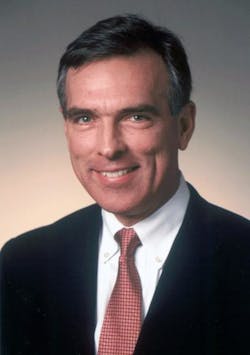Currently managing director and head of transportation capital markets research for Wall Street firm Stifel, Nicolaus & Co., Larkin (seen at right) has forgotten more about the freight markets than most people know, so it was interesting to receive an update from him distilling the broad perspective he’d gained from attending a bevy of conferences, trade shows, and one-on-one meetings with leading transportation firms over a recent 5-day stretch.
As an aside, Larkin tends to be fairly blunt in his freight assessments, too; let me share this example from a recent panel discussion I attended during FTR’s annual Transportation Conference last month:
“Ever since the big dip in freight during the Great Recession of 2008/2009, we’ve seen a new freight pattern emerging,” he explained. “The traditional Labor Day to Thanksgiving ‘freight peak’ is fading and doesn’t exist to some extent anymore. The new peak is the May/June timeframe where gas grills, lawn mowers and beer move in great quantities. This is a little different dynamic than we’ve seen historically.”
With that in mind, you’ll find a summation of his current perspectives on the direction of the U.S. economy and how it affects the freight market:
The U.S. economy remains mediocre at best. Many decision makers in the private sector are reluctant to aggressively hire, invest in capital projects, or carry any speculative inventory, Larkin said. For the most part, this has created flattish freight volumes across most modal sectors. An exception may be the temperature controlled space wherein population growth and expanded food offerings from big box retailers have generated a somewhat more constructive environment.
Rate increases difficult to get. Tank truck and flatbed operators are feeling a little better about demand, but were reluctant to suggest that any recent uptick was sustainable. Carriers with business into/out of Mexico are feeling optimistic; however, in general, freight, disappointingly, continues to move "sideways.” The big problem for truckers: price increases are difficult to implement as shippers are not experiencing any difficulties in procuring sufficient capacity, even after the July 1 implementation of the new hours-of-service (HOS) rules that cost the truckload industry anywhere from 1% to 4% in lost productivity. Once again the exception may be the temperature controlled sector within which rates are up between 1% and 3% year-over-year.
Compliant drivers remain scarce. Companies are pulling out all the stops to rectify this challenging situation, with pay raises being implemented. Bonus programs are being rolled out and expanded. Routing algorithms are being harnessed to maximize productivity of rolling stock and driving associates as well as get drivers home predictably. Collaboration with shippers is increasing in frequency and sophistication with the goal of turning equipment faster at origin and destination. So, despite the driver shortage, equipment is being harnessed more productively, thereby delaying the capacity shortage at least until the spring of 2014 and probably beyond that. Many suggested that the catalyst behind the ultimate driver shortage will be the mandatory use of ELDs (electronic logging devices)—which most likely will not become a reality until late 2015 or sometime in 2016.
There are too many freight brokers. The brokerable freight portion of the truckload market is nearing saturation as multiple, rapidly growing brokers continue adding capacity (i.e., growing headcount). Brokers are adding capacity faster than shippers are outsourcing traffic management functions. Effectively, brokers are calling all the same accounts. As the segment matures, margins are contracting. Winners will now be separated from losers on the basis of cost per transaction and consistency of service.
Good stuff to think on from someone’s whose knowledge of the freight industry runs pretty deep.




